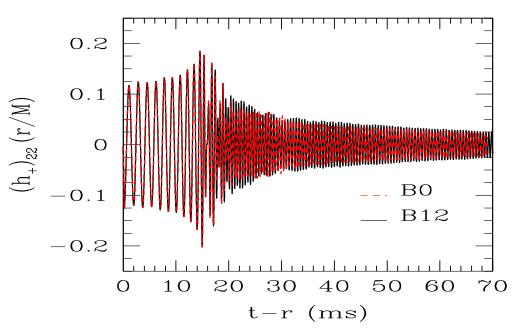Gravitational-wave signals, initial data, and movies can be found as supplemental material in the papers of my group:
- Endrizzi Andrea, Logoteta Domenico, Giacomazzo Bruno, Bombaci Ignazio, Kastaun Wolfgang, Ciolfi Riccardo 2018, Effects of Chiral Effective Field Theory Equation of State on Binary Neutron Star Mergers
- Kastaun et al 2017, Structure of stable binary neutron star merger remnants: Role of initial spin
- Ciolfi et al 2017, General relativistic magnetohydrodynamic simulations of binary neutron star mergers forming a long-lived neutron star
- Kawamura et al 2016, Binary neutron star mergers and short gamma-ray bursts: Effects of magnetic field orientation, equation of state, and mass ratio
- Endrizzi et al 2016, General relativistic magnetohydrodynamic simulations of binary neutron star mergers with the APR4 equation of state
Riccardo Ciolfi has also collected our gravitational wave signals in a bitbucket repository.
Below you can also find older data from a simulation performed when I was at JILA (Boulder, CO, USA).
Formation of Stable Magnetars from Binary Neutron Star Mergers
by Bruno Giacomazzo and Rosalba Perna
Abstract: By performing fully general relativistic magnetohydrodynamic simulations of binary neutron star mergers, we investigate the possibility that the end result of the merger is a stable magnetar. In particular, we show that, for a binary composed of two equal-mass neutron stars (NSs) of gravitational mass M ~ 1.2 M ⊙ and equation of state similar to Shen et al. at high densities, the merger product is a stable NS. Such NS is found to be differentially rotating and ultraspinning with spin parameter J/M2 ~ 0.86, where J is its total angular momentum, and it is surrounded by a disk of ≈0.1 M ⊙. While in our global simulations the magnetic field is amplified by about two orders of magnitude, local simulations have shown that hydrodynamic instabilities and the onset of the magnetorotational instability could further increase the magnetic field strength up to magnetar levels. This leads to the interesting possibility that, for some NS mergers, a stable and magnetized NS surrounded by an accretion disk could be formed. We discuss the impact of these new results for the emission of electromagnetic counterparts of gravitational wave signals and for the central engine of short gamma-ray bursts.
Data include gravitational wave signals for models B0 and B12 (both Zerilli waveforms that were used for figure 4 in the letter and psi4).
